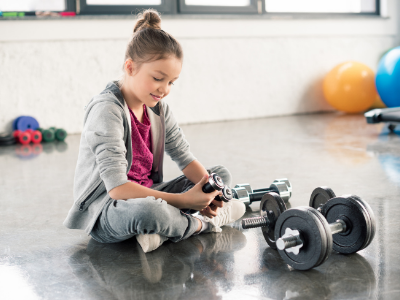My mother never taught me how to be physically strong.
Sure, she showed me what it meant to be mentally strong, emotionally strong, and transcend strength into my work, education, and personal aspirations — but being physically strong was not something I learned from her.
I wish it had been though.
Sure, she brought me to soccer practice five days a week and watched my games on the weekends. She made me go to conditioning for swim team when I definitely did not want to. She supported my dreams of becoming a starting center on the basketball team only to have those dreams thwarted when I didn’t grow past 5’1”. And she did it all with a smile on her face while making extensive sacrifices in her own life, and for that I thank her endlessly.
 But I wish she had been the one to show me how to work with weights. I wish she had been the one to put a dumbbell in my hand. I wish she had showed me how to wield a barbell, instead of thinking a man had to be the one to do it.
But I wish she had been the one to show me how to work with weights. I wish she had been the one to put a dumbbell in my hand. I wish she had showed me how to wield a barbell, instead of thinking a man had to be the one to do it.
Knowing what I know now, if I had learned how to properly strength train when I was young, I would have been a monumentally better soccer player, a faster and healthier swimmer, and maybe (just maybe) I would have been a semi-decent basketball player.
This is to no fault of my mother’s though. It’s a fault of a generation stuck in a hole of stereotypical thinking and lack of education on the safety of allowing children to strength train. Unfortunately, these are misconceptions that still ring true for far too many.
So, if you’re wondering: “When is it safe for my daughter (or son) to start strength training?” The answer is now. The answer is yesterday. The answer is whenever you feel like they are mature enough to follow instructions and you know of a qualified and reputable coach available to teach them proper technique.
But I hear you.
Is it safe?
Won’t it stunt their growth?
What about growth plate injuries?
Not Only Is Lifting Safe, It Prepares Children for Life
Let me ask you, how many times is that child going to pick up a suitcase? Or lift the side of the couch to reach for a fallen toy? Or sit in a chair and stand up with something in their hands? Or, does that child plan on playing sports? What happens when they collide with another player on the soccer field or tackle someone in football? Are you asking these same questions when they show interest in those sports and activities?
Not only has weightlifting been shown to enhance performance, it prevents injuries in other sports and activities.1
By teaching young children how to properly perform basic movement patterns (squat, push, pull, hinge, lunge), their biomechanics improve, their body awareness improves, and most importantly their confidence improves. I’ve seen this in multiple instances working in a facility with young athletes. They come to us unable to crawl or skip, and they’ll walk out of the building successfully front squatting with a barbell or deadlifting their body weight, and then some, off the ground.
 Furthermore, an injury to a growth plate has never been reported as a result of weight training, and among competitive youth weightlifters, no injuries were reported after a full year of training.2 Injuries that have been sustained from resistance training have been primarily attributed to misuse of the equipment, inappropriate technique, and lack of supervision.3 And even still, loading a barbell on their back won’t cause them to shrink or stop growing; youth resistance-training programs have little influence on growth in height and weight.4
Furthermore, an injury to a growth plate has never been reported as a result of weight training, and among competitive youth weightlifters, no injuries were reported after a full year of training.2 Injuries that have been sustained from resistance training have been primarily attributed to misuse of the equipment, inappropriate technique, and lack of supervision.3 And even still, loading a barbell on their back won’t cause them to shrink or stop growing; youth resistance-training programs have little influence on growth in height and weight.4
It is also perfectly safe for a child to find their one repetition max — of course under supervision — as the force they sustain from something like this is no more than forces they would experience in other sports.5
Coaching a child through a strength-training program should prioritize technique over everything though — the strength gains are a happy byproduct. By following a strength-training program, children can improve strength by 30 to 50 percent in just 8 to 12 weeks.2
If you can teach children how to move properly, you will give them the confidence to tackle any other obstacle in their life — it’s a liberating experience to be proud of what your body can do.
Confidence in Action
In September 2018 at Smart Fit Girls’ inaugural Unite for Strength powerlifting meet, I had the utmost pleasure of watching a 6-year-old girl by the name of Ava Brewer (remember that name) strut out onto a powerlifting platform like it ain’t no thing. And it is a thing. It’s a very scary thing actually.
The confidence she exuded was like nothing I had ever seen before from a 6-year-old. But it wasn’t always like that. At the age of five, Ava began talking about wanting to diet and be skinny after a boy in her class called her “fat,” despite not even being on the growth chart for her height and weight. “Lifting has completely reversed that,” says Ava’s mom, Laura Hartley. “The biggest thing it has done for her is give her confidence.”
 Ava was equally nervous and excited for her first meet. Weighing just 30 pounds and standing no more than 3’6”, she won the hearts of the crowd. “As soon as she did her first lift I knew she would be fine,” Hartley says. And she was. (She only missed one bench press attempt because the blocks under her feet — yep, she’s that small — weren’t in the right position.)
Ava was equally nervous and excited for her first meet. Weighing just 30 pounds and standing no more than 3’6”, she won the hearts of the crowd. “As soon as she did her first lift I knew she would be fine,” Hartley says. And she was. (She only missed one bench press attempt because the blocks under her feet — yep, she’s that small — weren’t in the right position.)
When deadlifts came around, her favorite lift, the 30-pound little ball of energy ripped a 45-pound barbell off the ground and smiled a smile I will never forget, while the crowd around her cheered.
Yet, in my own little circle of social media the concerns and skepticism rolled in.
This looks weird.
Is it safe for a child to be doing that?
Won’t she stunt her growth?
What about her growth plate?
I was discouraged that something so amazing to me was something that was so misconceived by others.
You Can Contribute to This Change
Ava is going to grow up with a training age (how many years you’ve been training) four times mine by the time she’s my age, if she keeps it up. She is going to pursue all the many things she loves to do including cheerleading, roller derby, and skating with so much confidence and gusto in what her body is able to do. And it all started with her mother, who brought home a barbell and a set of weights and showed her what it looked like to be physically strong.
Mothers, we need more of that. Sisters, daughters, friends, nieces, wives, we need you to show up for the girls in your life and show them how cool their body is. And if you don’t know where to turn, or are still a little skeptical, I urge you to look at girls like Happy Luma, Ava Brewer, and Addy Lifts, seek out organizations like Smart Fit Girls that encourage and support girls to pick up weights, and see how strength training has transformed their lives.
 When you are able to teach a young child how to move properly you erase self-doubt from their thinking and “can’t” from their vocabulary. You give them the confidence to go after whatever they want in this world.
When you are able to teach a young child how to move properly you erase self-doubt from their thinking and “can’t” from their vocabulary. You give them the confidence to go after whatever they want in this world.
And I can’t wait to watch how little girls like Ava Brewer continue to change the world and see where they’ll be in five, ten, fifteen years from now because I have a feeling it’ll be somewhere pretty amazing.
References
- Faigenbaum, A.D., Myer, G.D. Resistance training among young athletes: safety, efficacy and injury prevention effects. British Journal of Sports Medicine, 2009. https://www.researchgate.net/publication/40039109_Resistance_training_among_young_athletes_Safety_efficacy_and_injury_prevention_effects
- Byrd, R. et al. Young Weightlifter’ Performance Across Time. http://www.treinamentoesportivo.com/wp-content/uploads/2010/09/Young-Weightlifters-Performance-Across-Time.pdf
- Dahab, K., McCambridge, T. Strength training in children and adolescents. Sports Health. 2009. https://www.ncbi.nlm.nih.gov/pmc/articles/PMC3445252/
- Malina, R.M. Weight training in youth-growth, maturation, and safety: an evidence-based review. 2006. https://www.ncbi.nlm.nih.gov/pubmed/17119361
- Faigenbaum A.D., et al. Maximal testing in healthy children. Journal of Strength and Conditioning Research, 2003. http://citeseerx.ist.psu.edu/viewdoc/download?doi=10.1.1.491.8731&rep=rep1&type=pdf
